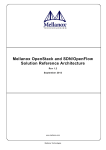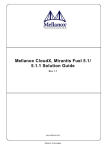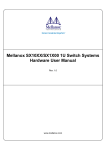Download Reference Guide
Transcript
Mellanox Reference Architecture for
Red Hat Enterprise Linux OpenStack
Platform 4.0
Rev 1.1
March 2014
www.mellanox.com
Mellanox Technologies
NOTE:
THIS HARDWARE, SOFTWARE OR TEST SUITE PRODUCT (“PRODUCT(S)”) AND ITS RELATED DOCUMENTATION ARE
PROVIDED BY MELLANOX TECHNOLOGIES “AS-IS” WITH ALL FAULTS OF ANY KIND AND SOLELY FOR THE PURPOSE OF
AIDING THE CUSTOMER IN TESTING APPLICATIONS THAT USE THE PRODUCTS IN DESIGNATED SOLUTIONS. THE
CUSTOMER'S MANUFACTURING TEST ENVIRONMENT HAS NOT MET THE STANDARDS SET BY MELLANOX
TECHNOLOGIES TO FULLY QUALIFY THE PRODUCT(S) AND/OR THE SYSTEM USING IT. THEREFORE, MELLANOX
TECHNOLOGIES CANNOT AND DOES NOT GUARANTEE OR WARRANT THAT THE PRODUCTS WILL OPERATE WITH THE
HIGHEST QUALITY. ANY EXPRESS OR IMPLIED WARRANTIES, INCLUDING, BUT NOT LIMITED TO, THE IMPLIED
WARRANTIES OF MERCHANTABILITY, FITNESS FOR A PARTICULAR PURPOSE AND NON INFRINGEMENT ARE
DISCLAIMED. IN NO EVENT SHALL MELLANOX BE LIABLE TO CUSTOMER OR ANY THIRD PARTIES FOR ANY DIRECT,
INDIRECT, SPECIAL, EXEMPLARY, OR CONSEQUENTIAL DAMAGES OF ANY KIND (INCLUDING, BUT NOT LIMITED TO,
PAYMENT FOR PROCUREMENT OF SUBSTITUTE GOODS OR SERVICES; LOSS OF USE, DATA, OR PROFITS; OR BUSINESS
INTERRUPTION) HOWEVER CAUSED AND ON ANY THEORY OF LIABILITY, WHETHER IN CONTRACT, STRICT LIABILITY,
OR TORT (INCLUDING NEGLIGENCE OR OTHERWISE) ARISING IN ANY WAY FROM THE USE OF THE PRODUCT(S) AND
RELATED DOCUMENTATION EVEN IF ADVISED OF THE POSSIBILITY OF SUCH DAMAGE.
Mellanox Technologies
350 Oakmead Parkway Suite 100
Sunnyvale, CA 94085
U.S.A.
www.mellanox.com
Tel: (408) 970-3400
Fax: (408) 970-3403
Mellanox Technologies, Ltd.
Beit Mellanox
PO Box 586 Yokneam 20692
Israel
www.mellanox.com
Tel: +972 (0)74 723 7200
Fax: +972 (0)4 959 3245
© Copyright 2014. Mellanox Technologies. All Rights Reserved.
Mellanox®, Mellanox logo, BridgeX®, ConnectX®, Connect-IB®, CORE-Direct®, InfiniBridge®, InfiniHost®, InfiniScale®, MetroX®,
MLNX-OS®, PhyX®, ScalableHPC®, SwitchX®, UFM®, Virtual Protocol Interconnect® and Voltaire® are registered trademarks of
Mellanox Technologies, Ltd.
ExtendX™, FabricIT™, Mellanox Open Ethernet™, Mellanox Virtual Modular Switch™, MetroDX™, Unbreakable-Link™ are trademarks
of Mellanox Technologies, Ltd.
All other trademarks are property of their respective owners.
2
Document Number: 15-954
Mellanox Technologies
Mellanox Reference Architecture for Red Hat Enterprise Linux OpenStack Platform 4.0
Rev 1.1
Contents
1
Solution Overview ........................................................................................................................... 7
2
Storage Acceleration Using Mellanox Interconnect .................................................................... 9
3
Network Virtualization on ConnectX-3 Adapters ....................................................................... 11
4
5
3.1
Performance Measurements ................................................................................................ 12
3.2
Seamless OpenStack Integration ......................................................................................... 12
Setup and Installation ................................................................................................................... 14
4.1
Hardware Requirements ....................................................................................................... 14
4.2
Software Requirements ........................................................................................................ 15
4.3
Prerequisites ......................................................................................................................... 15
4.4
OpenStack Software installation........................................................................................... 15
4.5
Troubleshooting .................................................................................................................... 16
Setting Up the Network ................................................................................................................ 17
5.1
5.2
Configuration Examples ....................................................................................................... 17
5.1.1
Creating a Network ................................................................................................. 17
5.1.2
Creating a Para-Virtualized vNIC Instance ............................................................. 18
5.1.3
Creating an SR-IOV Instance ................................................................................. 20
5.1.4
Creating a Volume .................................................................................................. 22
5.1.5
Attach a Volume ..................................................................................................... 23
Verification Examples ........................................................................................................... 24
5.2.1
Instances Overview ................................................................................................ 24
5.2.2
Connectivity Check ................................................................................................. 24
5.2.3
Volume Check ........................................................................................................ 25
3
Mellanox Technologies
Rev 1.1
Solution Overview
List of Figures
Figure 1: Mellanox OpenStack Architecture ............................................................................................ 8
Figure 2: OpenStack Based IaaS Cloud POD Deployment Example ..................................................... 9
Figure 3: RDMA Acceleration ................................................................................................................ 10
Figure 4: eSwitch Architecture............................................................................................................... 11
Figure 5: Latency Comparison .............................................................................................................. 12
Figure 6: Network Virtualization............................................................................................................. 13
Figure 7: Mellanox MCX314A-BCBT, ConnectX-3 40GbE/FDR 56Gb/s InfiniBand Adapter ............... 14
Figure 8: Mellanox SX1036, 36x 40GbE/ SX6036 36x FDR 56Gb/s InfiniBand ................................... 15
Figure 9: Mellanox 40GbE/FDR 56Gb/s InfiniBand, QSFP Copper Cable ........................................... 15
Figure 10: OpenStack Dashboard, Instances ....................................................................................... 18
Figure 11: OpenStack Dashboard, Launch Instance ............................................................................ 19
Figure 12: OpenStack Dashboard, Launch Interface - Select Network ................................................ 19
Figure 13: OpenStack Dashboard, Volumes ......................................................................................... 23
Figure 14: OpenStack Dashboard, Create Volumes ............................................................................. 23
Figure 15: OpenStack Dashboard, Volumes ......................................................................................... 23
Figure 16: OpenStack Dashboard, Manage Volume Attachments ....................................................... 24
Figure 17: VM Overview ........................................................................................................................ 24
Figure 18: Remote Console Connectivity .............................................................................................. 25
Figure 19: OpenStack Dashboard, Volumes ......................................................................................... 25
Figure 20: OpenStack Dashboard, Console .......................................................................................... 25
4
Mellanox Technologies Confidential
Mellanox Reference Architecture for Red Hat Enterprise Linux OpenStack Platform 4.0
Rev 1.1
Preface
About this Document
This reference design presents the value of using Mellanox interconnect products and
describes how to integrate Red Hat OpenStack technology with the end-to-end Mellanox
interconnect solution.
Audience
This reference design is intended for server and network administrators.
The reader must have experience with the basic OpenStack framework and installation.
References
For additional information, see the following documents:
Table 1: Related Documentation
Reference
Location
Red Hat Enterprise Linux OpenStack
Platform 4.0
https://access.redhat.com/products/Cloud/OpenStack/
Mellanox OFED User Manual
www.mellanox.com > Products > Adapter IB/VPI SW > Linux
SW/Drivers
http://www.mellanox.com/content/pages.php?pg=products_dy
n&product_family=26&menu_section=34
Mellanox software source packages
https://github.com/mellanox-openstack
OpenStack Website
www.openstack.org
Mellanox OpenStack wiki page
https://wiki.openstack.org/wiki/Mellanox-OpenStack
Mellanox Ethernet Switch Systems
User Manual
http://www.mellanox.com/related-docs/user_manuals/SX10X
X_User_Manual.pdf
Mellanox Ethernet adapter cards
http://www.mellanox.com/page/ethernet_cards_overview
Solutions space on Mellanox
community
http://community.mellanox.com/community/support/solutions
OpenStack RPM package
http://community.mellanox.com/docs/DOC-1187
5
Mellanox Technologies
Rev 1.1
Solution Overview
Reference
Location
Mellanox eSwitchd Installation for
OpenFlow and OpenStack
http://community.mellanox.com/docs/DOC-1126
Troubleshooting
http://community.mellanox.com/docs/DOC-1127
Mellanox OFED Driver Installation
and Configuration for SR-IOV
http://community.mellanox.com/docs/DOC-1317
Revision History
Table 2: Document Revision History
Revision
Date
Changes
1.1
March 2014
Aligned document to Havana release.
1.0
2013
Initial revision
6
Mellanox Technologies Confidential
Mellanox Reference Architecture for Red Hat Enterprise Linux OpenStack Platform 4.0
1
Rev 1.1
Solution Overview
Deploying and maintaining a private or public cloud is a complex task – with various vendors
developing tools to address the different aspects of the cloud infrastructure, management,
automation, and security. These tools tend to be expensive and create integration challenges
for customers when they combine parts from different vendors. Traditional offerings suggest
deploying multiple network and storage adapters to run management, storage, services, and
tenant networks. These also require multiple switches, cabling, and management
infrastructure, which increases both up front and maintenance costs.
Other, more advanced offerings provide a unified adapter and first level Top-of-Rack (ToR)
switch, but still run multiple and independent core fabrics. Such offerings tend to suffer from
low throughput because they do not provide the aggregate capacity required at the edge or in
the core; and because they deliver poor application performance due to network congestion
and lack of proper traffic isolation.
Several open source “cloud operating system” initiatives have been introduced to the market,
but none has gained sufficient momentum to succeed. Recently OpenStack has managed to
establish itself as the leading open source cloud operating system, with wide support from
major system vendors, OS vendors, and service providers. OpenStack allows central
management and provisioning of compute, networking, and storage resources, with
integration and adaptation layers allowing vendors and/or users to provide their own plug-ins
and enhancements.
Red Hat built an industry leading certification program for their OpenStack platform. By
achieving this technology certification, vendors can assure customers that their solutions have
been validated with Red Hat OpenStack technology. Mellanox is the first InfiniBand and
Ethernet adapter vendor to be listed on the Red Hat Certified Solution Marketplace, a directory
of technologies and products which have been certified by Red Hat and are designed to
optimize all offerings that include Red Hat OpenStack. Mellanox is listed in the Red Hat
marketplace as a certified Hardware partner for Networking (Neutron) and Block Storage
(Cinder) services. This ensures that Mellanox ConnectX-3 InfiniBand and Ethernet adapter
was tested, certified, and now supported with Red Hat OpenStack technology.
Red Hat Enterprise Linux OpenStack Platform 4.0 delivers an integrated foundation to create,
deploy, and scale a secure and reliable public or private OpenStack cloud. Red Hat Enterprise
OpenStack Platform 4.0 combines the world’s leading enterprise Linux and the
fastest-growing cloud infrastructure to give you the agility to scale and quickly meet customer
demands without compromising on availability, security, or performance.
Mellanox Technologies offers seamless integration between InfiniBand and Ethernet
interconnect and OpenStack services and provides unique functionality that includes
application and storage acceleration, network provisioning, automation, hardware-based
security, and isolation. Furthermore, using Mellanox interconnect products allows cloud
providers to save significant capital and operational expenses through network and I/O
consolidation and by increasing the number of virtual machines (VMs) per server.
Mellanox provides a variety of network interface cards (NICs) supporting one or two ports of
10GbE, 40GbE, or 56Gb/s InfiniBand. These adapters simultaneously run management,
7
Mellanox Technologies
Rev 1.1
Solution Overview
network, storage, messaging, and clustering traffic. Furthermore, these adapters create virtual
domains within the network that deliver hardware-based isolation and prevent cross-domain
traffic interference.
In addition, Mellanox Virtual Protocol Interconnect® (VPI) switches deliver the industry’s
most cost-effective and highest capacity InfiniBand or Ethernet switches (supporting up to 36
ports of 56Gb/s). When deploying large-scale, high-density infrastructures, leveraging
Mellanox converged network VPI solutions translates into fewer switching elements, far
fewer optical cables, and simpler network design.
Mellanox integration with OpenStack provides the following benefits:
Cost-effective and scalable infrastructure that consolidates the network and storage to a
highly efficient flat fabric, increases the VM density, normalizes the storage
infrastructure, and linearly scales to thousands of nodes
Delivers the best application performance with hardware-based acceleration for
messaging, network traffic, and storage
Easy to manage via standard APIs. Native integration with OpenStack Networking
Neutron and Block Storage (Cinder) provisioning APIs
Provides tenant and application security/isolation, end-to-end hardware-based traffic
isolation, and security filtering
Figure 1: Mellanox OpenStack Architecture
8
Mellanox Technologies Confidential
Mellanox Reference Architecture for Red Hat Enterprise Linux OpenStack Platform 4.0
2
Rev 1.1
Storage Acceleration Using Mellanox
Interconnect
Data centers rely on communication between compute and storage nodes, as compute servers
read and write data from the storage servers constantly. In order to maximize the server’s
application performance, communication between the compute and storage nodes must have
the lowest possible latency, highest possible bandwidth, and lowest CPU utilization.
Figure 2: OpenStack Based IaaS Cloud POD Deployment Example
Storage applications that use iSCSI over TCP are processed by the CPU. This causes data
center applications that rely heavily on storage communication to suffer from reduced CPU
utilization, as the CPU is busy sending data to the storage servers. The data path for protocols
such as TCP, UDP, NFS, and iSCSI all must wait in line with the other applications and
system processes for their turn using the CPU. This not only slows down the network, but also
uses system resources that could otherwise have been used for executing applications faster.
Mellanox OpenStack solution extends the Cinder project by adding iSCSI running over
RDMA (iSER). Leveraging RDMA Mellanox OpenStack delivers 5X better data throughput
(for example, increasing from 1GB/s to 5GB/s) and requires up to 80% less CPU utilization
(see Figure 3).
Mellanox ConnectX®-3 adapters bypass the operating system and CPU by using RDMA,
allowing much more efficient data movement paths. iSER capabilities are used to accelerate
hypervisor traffic, including storage access, VM migration, and data and VM replication. The
use of RDMA moves data to the Mellanox ConnectX-3 hardware, which provides zero-copy
message transfers for SCSI packets to the application, producing significantly faster
performance, lower network latency, lower access time, and lower CPU overhead. iSER can
provide 6x faster performance than traditional TCP/IP based iSCSI. This also consolidates the
efforts of both Ethernet and InfiniBand communities, and reduces the number of storage
protocols a user must learn and maintain.
9
Mellanox Technologies
Rev 1.1
Storage Acceleration Using Mellanox Interconnect
The RDMA bypass allows the data path to effectively skip to the front of the line. Data is
provided directly to the application immediately upon receipt without being subject to various
delays due to CPU load-dependent software queues. This has three effects:
There is no waiting, which means that the latency of transactions is incredibly low.
Because there is no contention for resources, the latency is consistent, which is essential
for offering end users with a guaranteed SLA.
By bypassing the OS, using RDMA results in significant savings in CPU cycles. With a
more efficient system in place, those saved CPU cycles can be used to accelerate
application performance.
In the following diagram, it is clear that by performing hardware offload of the data transfers
using the iSER protocol, the full capacity of the link is utilized to the maximum of the PCIe
limit.
To summarize, network performance is a significant element in the overall delivery of data
center services. To produce the maximum performance for data center services requires fast
interconnects. Unfortunately the high CPU overhead associated with traditional storage
adapters prevents taking full advantage of high speed interconnects. Many more CPU cycles
are needed to process TCP and iSCSI operations compared to that required by the RDMA
(iSER) protocol performed by the network adapter. Hence, using RDMA-based fast
interconnects significantly increases data center performance levels.
Figure 3: RDMA Acceleration
10
Mellanox Technologies Confidential
Mellanox Reference Architecture for Red Hat Enterprise Linux OpenStack Platform 4.0
3
Rev 1.1
Network Virtualization on ConnectX-3 Adapters
Single Root IO Virtualization (SR-IOV) allows a physical PCIe device to present itself as
multiple devices on the PCIe bus. This technology enables a single adapter to provide multiple
virtual instances of the device with separate resources. Mellanox ConnectX®-3 adapters are
capable of exposing 127 virtual instances called Virtual Functions (VFs). These virtual
functions can then be provisioned separately. Each VF can be viewed as an additional device
associated with the Physical Function. It shares the same resources with the Physical Function,
and its number of ports equals those of the Physical Function.
SR-IOV is commonly used in conjunction with an SR-IOV enabled hypervisor to provide
virtual machines with direct hardware access to network resources, thereby improving
performance.
Mellanox ConnectX-3 adapters equipped with onboard embedded switch (eSwitch) are
capable of performing layer-2 switching for the different VMs running on the server. Using
the eSwitch will gain higher performance levels in addition to security and QoS.
Figure 4: eSwitch Architecture
eSwitch main capabilities and characteristics:
Virtual switching: creating multiple logical virtualized networks. The eSwitch offload
engines handle all networking operations up to the VM, thereby dramatically reducing
software overheads and costs.
Performance: The switching is handled in hardware, as opposed to other applications that
use a software-based switch. This enhances performance by reducing CPU overhead.
Security: The eSwitch enables network isolation (using VLANs) and anti-MAC spoofing.
11
Mellanox Technologies
Rev 1.1
3.1
Network Virtualization on ConnectX-3 Adapters
QoS: The eSwitch supports traffic class management, priority mapping, rate limiting, and
scheduling. In addition, DCBX control plane can set Priority Flow Control (PFC) and FC
parameters on the physical port.
Monitoring: Port counters are supported.
Performance Measurements
Many data center applications require lower latency network performance. Some applications
require latency stability as well. Using regular TCP connectivity between VMs can create high
latency and unpredictable delay behavior.
Figure 5 shows the dramatic difference (20X) when using para-virtualized vNIC running a
TCP stream compared to SR-IOV connectivity running RDMA.
Due to the direct connection of the SR-IOV and the ConnectX-3 hardware capabilities, there is
a significant reduction in software interference that adds unpredictable delay to the packet
processing.
Figure 5: Latency Comparison
3.2
Seamless OpenStack Integration
The eSwitch configuration is transparent to the Red Hat Enterprise Linux OpenStack Platform
4.0 administrator. The installed eSwitch daemon on the server is responsible for hiding the
low-level configuration. The administrator will use the OpenStack dashboard for the fabric
management.
12
Mellanox Technologies Confidential
Mellanox Reference Architecture for Red Hat Enterprise Linux OpenStack Platform 4.0
Rev 1.1
Figure 6: Network Virtualization
13
Mellanox Technologies
Rev 1.1
4
Setup and Installation
Setup and Installation
The following setup is suggested for small scale applications.
The OpenStack environment should be installed according to the Red Hat OpenStack
Enterprise Linux installation guide. Refer to
https://access.redhat.com/site/documentation/Red_Hat_OpenStack/
In addition, the following installation changes should be applied:
4.1
A controller node running the Networking (neutron) service should be installed with the
Mellanox neutron plugin.
A Cinder patch should be applied to the storage servers (for iSER support).
Mellanox Neutron agent, eSwitch daemon, and Nova patches should be installed on the
compute notes.
Hardware Requirements
Mellanox ConnectX-3 or ConnectX-3 Pro 10/40GbE and FDR 56Gb/s InfiniBand adapter
cards
10GbE or 40GbE Ethernet or FDR 56Gb/s InfiniBand switches
Cables required for the ConnectX-3 card (typically using SFP+ connectors for 10GbE or
QSFP connectors for 40GbE and FDR 56Gb/s InfiniBand)
Server nodes should comply with Red Hat Enterprise Linux OpenStack Platform 4.0
requirements.
Compute nodes should have SR-IOV capability (BIOS). SR-IOV is supported by RHEL
6.4 and above.
There are many options in terms of adapters, cables, and switches. See www.mellanox.com for
additional options.
Figure 7: Mellanox MCX314A-BCBT, ConnectX-3 40GbE/FDR 56Gb/s InfiniBand Adapter
14
Mellanox Technologies Confidential
Mellanox Reference Architecture for Red Hat Enterprise Linux OpenStack Platform 4.0
Rev 1.1
Figure 8: Mellanox SX1036, 36x 40GbE/ SX6036 36x FDR 56Gb/s InfiniBand
Figure 9: Mellanox 40GbE/FDR 56Gb/s InfiniBand, QSFP Copper Cable
4.2
Software Requirements
Red Hat Enterpise Linux OpenStack Platform 4.0 switch includes
o
4.3
Red Hat OpenStack 3 or later
Red Hat Enterpise Linux 6.4 or later. The specific release is determined by the Red Hat
OpenStack version.
Mellanox OFED 2.0.3 (SR-IOV support)
Prerequisites
(1) The basic setup is physically connected.
In order to reduce the number of ports in the network, two different networks can be
mapped to the same physical interface on two different VLANs.
(2) Mellanox OFED 2.0.3 (SR-IOV enabled) is installed on each of the network adapters.
4.4
For Mellanox OFED installation refer to Mellanox OFED User Manual (Installation
chapter).
http://www.mellanox.com/page/products_dyn?product_family=26
Visit Mellanox Community – for verification options and adaptation.
http://community.mellanox.com/docs/DOC-1317
OpenStack Software installation
For Mellanox OpenStack installation, follow the Mellanox OpenStack wiki pages:
Neutron: https://wiki.openstack.org/wiki/Mellanox-Neutron
Cinder: https://wiki.openstack.org/wiki/Mellanox-Cinder
15
Mellanox Technologies
Rev 1.1
Setup and Installation
For the eSwitch daemon installation, follow the OpenStack wiki pages (part of Mellanox
Neutron):
4.5
Troubleshooting
Troubleshooting actions for OpenStack installation with Mellanox plugins can be found at
http://community.mellanox.com/docs/DOC-1127.
16
Mellanox Technologies Confidential
Mellanox Reference Architecture for Red Hat Enterprise Linux OpenStack Platform 4.0
5
Setting Up the Network
5.1
Configuration Examples
Rev 1.1
Once the installation is completed, it is time to set up the network.
Setting up a network consists of the following steps:
(1) Creating a network
(2) Creating a VM instance. Two types of instances can be created:
a. Para-virtualized vNIC
b. SR-IOV direct path connection
(3) Creating a disk volume
(4) Binding the disk volume to the instance that was just created
5.1.1
Creating a Network
Use the commands neutron net-create and neutron subnet-create to create a
new network and a subnet (“net-example” in the example).
$neutron net-create net-example
Created a new network:
+---------------------------+--------------------------------------+
| Field
| Value
|
+---------------------------+--------------------------------------+
| admin_state_up
| True
|
| id
| 16b790d6-4f5a-4739-a190-7598f331b696 |
| name
| net-example
|
| provider:network_type
| vlan
|
| provider:physical_network | default
|
| provider:segmentation_id | 4
|
| shared
| False
|
| status
| ACTIVE
|
| subnets
|
|
| tenant_id
| 679545ff6c1e4401adcafa0857aefe2e
|
+---------------------------+--------------------------------------+
17
Mellanox Technologies
Rev 1.1
Setting Up the Network
$neutron subnet-create net-example 192.168.199.0/24
Created a new subnet:
+------------------+------------------------------------------------------+
| Field
| Value
|
+------------------+------------------------------------------------------+
| allocation_pools | {"start": "192.168.199.2", "end": "192.168.199.254"} |
| cidr
| 192.168.199.0/24
|
| dns_nameservers |
|
| enable_dhcp
| True
|
| gateway_ip
| 192.168.199.1
|
| host_routes
|
|
| id
| 3c9ff1ae-218d-4020-b065-a2991d23bb72
|
| ip_version
|4
|
| name
|
|
| network_id
| 16b790d6-4f5a-4739-a190-7598f331b696
|
| tenant_id
| 679545ff6c1e4401adcafa0857aefe2e
|
+------------------+------------------------------------------------------+
5.1.2
Creating a Para-Virtualized vNIC Instance
(1) Using the OpenStack Dashboard, launch an instance (VM) using the Launch Instance
button.
(2) Insert all the required parameters and click Launch.
This operation will create a macvtap interface on top of a Virtual Function (VF).
Figure 10: OpenStack Dashboard, Instances
18
Mellanox Technologies Confidential
Mellanox Reference Architecture for Red Hat Enterprise Linux OpenStack Platform 4.0
Rev 1.1
Figure 11: OpenStack Dashboard, Launch Instance
(3) Select the desired network for the vNIC (‘net3’ in the example).
Figure 12: OpenStack Dashboard, Launch Interface - Select Network
19
Mellanox Technologies
Rev 1.1
5.1.3
Setting Up the Network
Creating an SR-IOV Instance
1. Use the command neutron port-create for the selected network (‘net3’ in the
example) to create a port with ‘vnic_type=hostdev’.
$neutron port-create net-example --binding:profile type=dict vnic_type=hostdev
Created a new port:
+----------------------+--------------------------------------------------------|
| Field
| Value
|
+----------------------+--------------------------------------------------------|
| admin_state_up
| True
|
| binding:capabilities | {"port_filter": false}
|
| binding:host_id
|
|
| binding:profile
| {"physical_network": "default"}
|
| binding:vif_type
| hostdev
|
| device_id
|
|
| device_owner
|
|
| fixed_ips
| {"subnet_id": "3c9ff1ae-218d-4020-b065-a2991d23bb72", |
"ip_address": "192.168.199.2"}
|
| id
| a43d35f3-3870-4ae1-9a9d-d2d341b693d6
|
| mac_address
| fa:16:3e:67:ad:ef
|
| name
|
|
| network_id
| 16b790d6-4f5a-4739-a190-7598f331b696
|
| status
| DOWN
|
| tenant_id
| 679545ff6c1e4401adcafa0857aefe2e
|
+----------------------+--------------------------------------------------------|
20
Mellanox Technologies Confidential
Mellanox Reference Architecture for Red Hat Enterprise Linux OpenStack Platform 4.0
Rev 1.1
2. Use the command nova boot to launch an instance with the created port attached.
$nova boot --flavor m1.small --image rh6.4p --nic
port-id=a43d35f3-3870-4ae1-9a9d-d2d341b693d6 vm3
+--------------------------------------+--------------------------------------+
| Property
| Value
|
+--------------------------------------+--------------------------------------+
| OS-EXT-STS:task_state
| scheduling
|
| image
| rh6.4p
|
| OS-EXT-STS:vm_state
| building
|
| OS-EXT-SRV-ATTR:instance_name
| instance-00000042
|
| OS-SRV-USG:launched_at
| None
|
| flavor
| m1.small
|
| id
| 161da6a9-6508-4e23-9f6f-881383461ab4 |
| security_groups
| [{u'name': u'default'}]
|
| user_id
| b94edf2504c84223b58e254314528902
|
| OS-DCF:diskConfig
| MANUAL
|
| accessIPv4
|
|
| accessIPv6
|
|
| progress
| 0
|
| OS-EXT-STS:power_state
| 0
|
| OS-EXT-AZ:availability_zone
| nova
|
| config_drive
|
|
| status
| BUILD
|
| updated
| 2013-12-19T07:32:42Z
|
| hostId
|
|
| OS-EXT-SRV-ATTR:host
| None
|
| OS-SRV-USG:terminated_at
| None
|
| key_name
| None
|
| OS-EXT-SRV-ATTR:hypervisor_hostname | None
|
| name
| vm3
|
| adminPass
| tiTE37tQrNBn
|
| tenant_id
| 679545ff6c1e4401adcafa0857aefe2e
|
| created
| 2013-12-19T07:32:41Z
|
| os-extended-volumes:volumes_attached | []
|
| metadata
| {}
|
+--------------------------------------+--------------------------------------+
5.1.4
Creating a Volume
Create a volume using the Volumes tab on the OpenStack dashboard. Click the Create Volume
button.
21
Mellanox Technologies
Rev 1.1
Setting Up the Network
Figure 13: OpenStack Dashboard, Volumes
Figure 14: OpenStack Dashboard, Create Volumes
Figure 15: OpenStack Dashboard, Volumes
5.1.5
Attach a Volume
Attach a volume to the desired instance.
22
Mellanox Technologies Confidential
Mellanox Reference Architecture for Red Hat Enterprise Linux OpenStack Platform 4.0
Rev 1.1
Figure 16: OpenStack Dashboard, Manage Volume Attachments
5.2
Verification Examples
5.2.1
Instances Overview
Use the Dashboard to view all configured instances.
Figure 17: VM Overview
5.2.2
Connectivity Check
There are many options for checking connectivity between difference instances, one of which
is simply to open a remote console and ping the required host.
To launch a remote console for a specific instance, select the Console tab and launch the
console.
23
Mellanox Technologies
Rev 1.1
Setting Up the Network
Figure 18: Remote Console Connectivity
5.2.3
Volume Check
To verify that the created volume is attached to a specific instance, click the Volumes tab.
Figure 19: OpenStack Dashboard, Volumes
Additionally, run the fdisk command from the instance console to see the volume details.
Figure 20: OpenStack Dashboard, Console
24
Mellanox Technologies Confidential




































